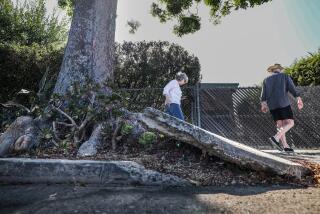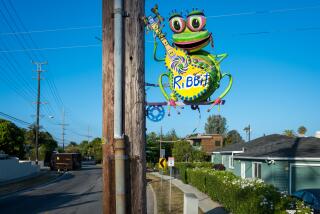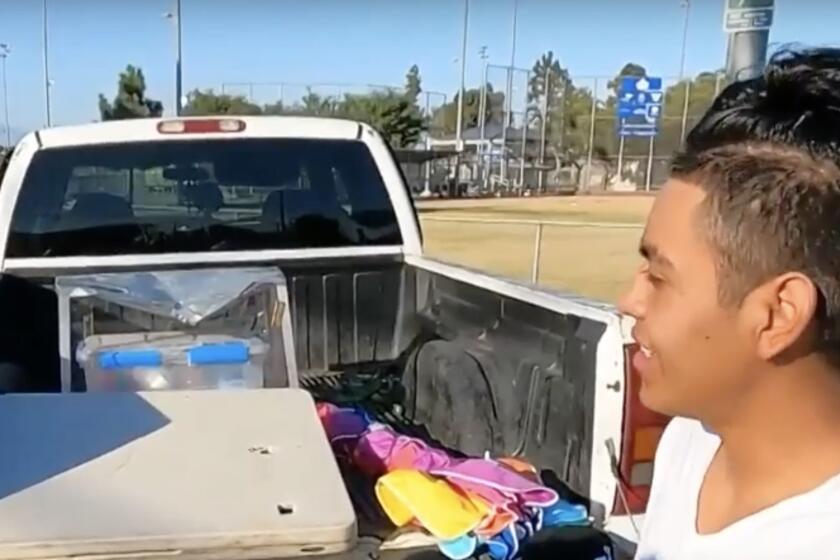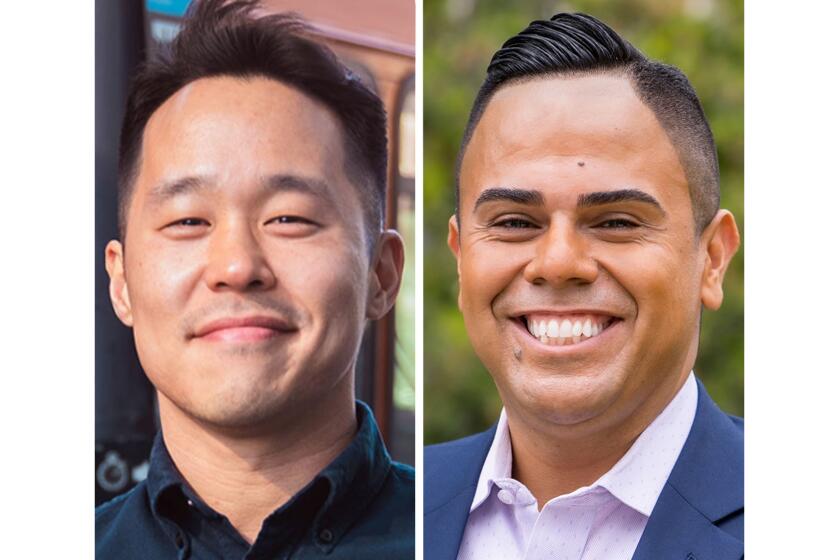Chalk draws Occupy L.A., LAPD into conflict over a wider struggle
It’s just chalk.
The stuff teachers used to explain math equations, before high-tech whiteboards and PowerPoint. The stuff kids use to draw hopscotch grids on the sidewalk. The stuff cops used to outline homicide victims’ bodies before the coroner carts them off.
That’s why I have a hard time understanding how chalk drawings sparked a violent melee last week at one of the city’s most popular cultural events.
Seventeen people were arrested and several officers and bystanders were injured when police moved in on Occupy L.A. activists whose chalk drawings were meant to engage the crowd at Art Walk a monthly showcase and celebration of art, food and entertainment that turns downtown into a giant party.
The event draws thousands to downtown each month — families, hipsters, couples and senior citizens — to art-shop and barhop in a newly revitalized downtown that’s not dark and dangerous anymore.
About a dozen activists from Occupy L.A. turned out too, scrawling slogans on the sidewalk to call attention to their campaign to pressure a downtown business group to scale back development that they say would limit options for low-income residents.
“We didn’t consider it a protest,” said Occupy L.A.’s Cheryl Aichele. “We were just passing out fliers and offering chalk to visitors,” she said. They had run-ins with police before, but intended “to not provoke them,” she said.
“We considered it outreach, a chance to have fun.”
The Art Walk visitors strolling Spring Street were there to have fun as well. Instead, they witnessed a series of ugly confrontations as — depending on whose side you’re on — police strong-armed peaceful protesters or troublemaking provocateurs riled up the crowd.
“The only time we took any action against them is when they refused to comply with the law,” insisted Capt. Horace Frank, who heads LAPD’s Central Division. The protesters were courting trouble, he said; writing on the pavement and blocking the sidewalk. “We’d arrest one or two, then one or two more....”
Within a few hours, the crowd had grown to a couple hundred people. They were blocking 5th Street and Spring, Frank said.
Police declared it an unlawful assembly and ordered them to disperse. Someone tossed a bottle and hit an officer, which led to a tactical alert.
That slows crime response across the city by diverting hundreds of officers to the brewing trouble spot.
All because a handful of rabble-rousers armed with chalk were writing on the sidewalk.
::
This, of course, was not really about chalk. It was the reflection of a power struggle; a ongoing clash whose combatants can’t be neatly defined by the 1% vs. 99% formula.
Occupy L.A. sees it as a war between rich and poor. The LAPD says it’s between anarchy and law and order.
And those Art Walk visitors greeted by turmoil as they tried to enjoy a night on the town probably see it as a troubling sign that — even in the midst of a civic celebration — no, we can’t all get along.
Frank said the activists’ “artistic freedom” was trampling others’ rights to safety and peace. “A lot of what they’re writing is extremely offensive.... There are families that live downtown; people walking with their kids on the sidewalk that night.
“Would you like to be the person who walks out and sees that stuff? ... It’s an absolute mess. That’s not fair to them,” Frank said.
Since its months-long City Hall tent encampment ended, Occupy L.A. has aligned itself with activists lobbying for skid row’s poor and homeless. “We’re not against the people moving downtown,” Aichele said, “but against the displacement of the low-income, small businesses, minorities.”
Their symbol of that is the Central City Assn., an advocacy and lobbying group for downtown developers and big business, with a membership roster its website calls “L.A.’s most powerful Rolodex.”
Occupy L.A. activists have targeted it for months, disrupting meetings and mixers, and chalking up walls and sidewalks around the association’s Wilshire Boulevard offices.
“They’re against everything that fundamentally the Occupy movement is for,” said Aichele.
::
Aichele said the police crackdown has raised the profile of Occupy L.A.; made it relevant again. It is getting lots more ‘likes’ on its Facebook page, along with photos and videos that document Thursday night’s “injustice,” she said.
“People saw the overreaction, and they were upset,” she said. “If the LAPD would have just let us be and have our peaceful outreach, we probably wouldn’t be getting so much sympathy.”
But they deserve some blame as well for trying to hijack a feel-good symbol of a downtown renaissance that, managed right, stands to benefit all of us.
It’s hard to explain how exciting the new Spring Street feels if you don’t remember how dark and dreary it was 30 years ago. Then, I couldn’t wait to leave work when my shift ended and had to look over my shoulder on every step to the parking lot.
Now I’m heading back downtown on weekends to visit hot spots and socialize. The people I meet are part of the 99% that Occupy L.A. claims to represent. Young people who moved downtown from dorms, doubling and tripling up so they don’t have live at home. Working folks who have scrapped a long commute for a high-rise view and no mortgage. Artists looking for space; transplants looking for city life.
There are a lot of problems that still need to be solved. Downtown’s health — our city’s future — depends not just on these pioneering, avant-garde newcomers, but on others willing to venture out on a summer night to see what the hoopla is all about.
We need to welcome people downtown, not frighten them off, whether with vile slogans written in chalk or police wearing riot gear.
More to Read
Sign up for Essential California
The most important California stories and recommendations in your inbox every morning.
You may occasionally receive promotional content from the Los Angeles Times.










